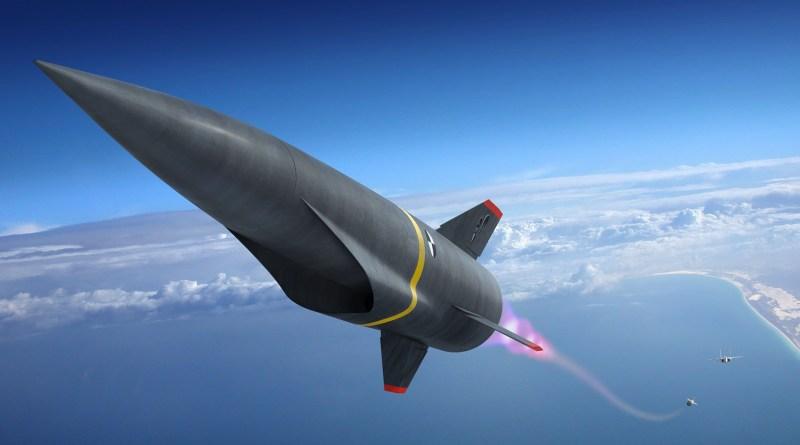
LOS ANGELES and WASHINGTON—A scramjet-powered missile developed under the joint DARPA/U.S. Air Force Hypersonic Air-breathing Weapon Concept (HAWC) program was destroyed in a recent test accident, Aerospace DAILY has learned.
The missile is believed to have inadvertently separated from a B-52 carrier aircraft during a captive-carry flight test, according to sources familiar with the evaluation. The cause of the mishap, which is thought to have involved an aircraft from the 419th Flight Test Squadron at Edwards AFB, California, is under investigation.
The Air Force referred questions about the incident to DARPA, but the agency declined to provide any details. “Details of those flight demonstrations are classified,” a DARPA spokesman said.
Aerospace DAILY understands pieces of the instrumented test article were recovered after the accident. The description could suggest the payload inadvertently detached from the B-52 in flight, rather than during ground tests or on the runway. It also suggests the mishap potentially occurred over land—possibly over a designated test range such as the Edwards Precision Impact Range Area or the nearby Naval Air Weapons Station test range at China Lake—rather than during transit for a wet dress rehearsal or live fire test over the Pacific range.
The mishap adds to the mysteries shrouding the status of the HAWC program, which is already several months behind an original schedule that called for a first flight in 2019. DARPA originally selected Lockheed Martin in 2017 to develop a HAWC demonstrator powered by an Aerojet Rocketdyne scramjet, having rejected an alternative design submitted by Raytheon. However, a redesigned Raytheon missile impressed DARPA, leading to a contract award for a second flight demonstration in March 2019.
As of June 2019, Lockheed and Raytheon executives were optimistic that captive-carry and free-flight tests for both HAWC concepts would occur by the end of 2019, but the end of the year passed with no report of either milestone being passed. It is believed the Lockheed Martin HAWC variant was involved in the recent incident.
The Air Force also is working with DARPA on tests of an unpowered Tactical Boost Glide (TBG) demonstrator, and in parallel is testing a prototype of another boosted glide vehicle: the Lockheed Martin AGM-183A Air Launched Rapid Response Weapon, or ARRW. The initial captive-carry flight test of the AGM-183A was conducted by a 419th Flight Test Squadron B-52 in June 2019 but no further updates on test progress have emerged since. The Air Force has said, however, that it plans to buy at least eight ARRW prototypes to support live-fire flight testing, which is set to begin in 2021.
Although the Air Force has focused initial development efforts on boosted hypersonic weapons, the service is looking to extend its interest in air-breathing systems beyond HAWC. In late April, the Air Force launched a market research study for a hypersonic cruise missile, signaling interest in an operational follow-on to a scramjet-powered weapon program.
Editor’s note: In September, defense DARPA told Aviation Week that Lockheed had completed the captive carry test, that although the vehicle sustained damage, it did not fall off the aircraft and that all objectives for the test were met.







Comments
2. missile did not separate from the B-52
3. no pieces were recovered
4. payload did not detach
5. neither Edwards range nor China Lake range were used
6. TBG is not unpowered